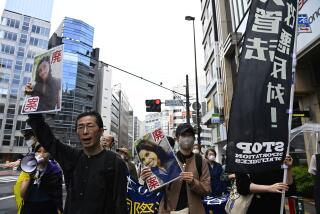It Takes Really Bad News to Move Japan
- Share via
The gloom surrounding Japan’s stagnating economy has never been thicker. But there is some good news. It is precisely that the bad news about Japan is getting worse. It seems to be a characteristic of Japan and Japanese organizations that they don’t alter course on a system until it is crystal clear that the system simply will not work any longer and that disaster threatens if dramatic changes are not made.
Consider two examples from Japanese history. By the middle 1800s, the feudalistic system of the Tokugawa shogunate had been obsolete for more than a century. While the Japanese eschewed technological advances and contact with the outside world, the rest of the world forged ahead into the Industrial Age. As a result, when Commodore Matthew Perry showed up in Tokyo Bay in 1853, the Japanese had mainly samurai swords with which to confront his squadron of modern warships. Faced with the threat of invasion and colonization, reformers in Japan seized the occasion to carry out the Meiji era restoration and reform that led to the modernization of Japan and its entrance into the front rank of nations by the turn of the century.
The second example is the Japanese experience in World War II. Although it was clear by the end of 1943 that Japan had lost the war, it continued doggedly planning to fight to the last person for nearly two more years. Only when the emperor, in response to impending disaster, took the unprecedented step of speaking directly to the nation to urge change was Japan able to end the war and begin laying the foundations for the renaissance that came to be known as the “Japanese miracle.”
Today, Japan is at another turning point. Since the time of the Meiji reformers, Japan has been operating what might be called the “catch-up” system. Introduced in response to the threat posed by Perry, it aimed to enable Japan to equal the West by introducing Western technology and techniques into Japanese organizations and social structures. Although World War II and its aftermath changed much in Japan, the fundamental economic system was not altered. Instead, in an attempt to ensure that Japan never again had to face defeat, the drive to “catch up” was intensified.
The government adopted policies that compelled a high savings rate, channeled low-cost capital to key industries, kept the yen undervalued, protected domestic markets and promoted export-led growth. To protect Japanese companies from foreign takeover, the keiretsu system of cross-shareholdings was fostered, as was the “convoy system” under which industries moved at the pace of their slowest members with no major company or bank being allowed to fail. Labor peace was bought through adoption of lifetime employment, and social harmony was maintained by preserving inefficient sectors through heavy subsidization.
But this system, which produced the “miracle,” was wheezing badly by the mid-1980s. Japan’s huge trade surpluses led to demands that its markets be opened to foreign competitors, and the forces pushing the undervalued yen upward became irresistible. In an attempt to keep the old export-led, catch-up system going, Japanese leaders flooded the system with liquidity (easy money). For a while the ensuing bubble made Japan look 10 feet tall. But when the bubble burst, it became clear that the system had major problems as banks threatened to collapse while insurance companies and pension funds stood on the precipice of bankruptcy.
Over the past 10 years, Japanese leaders have attempted to shore up the faltering system by throwing unprecedented sums of money at it, and they have been encouraged in this by many Western leaders and financial experts. But stimulus package after stimulus package and massive injections of new capital into the banks have barely kept the economy above water. The problem is that the system is so distorted that enormous amounts of spending are required to produce just a little stimulus.
Theoretically, the stimulus policies should facilitate structural reform and elimination of the distortions. In fact, they exacerbated the structural problems. The heart of the problem is Japan’s long-ruling Liberal Democratic Party. It is married to all the most protected, least productive, most highly subsidized sectors because of the political support they provide. Industries such as construction, real estate, agriculture and telecommunications are in desperate need of reform. But for the LDP to engage in serious restructuring means political suicide.
The situation is far from hopeless. Many of Japan’s leading companies, like Sony, Toyota and Toshiba, have restructured and become fully competitive in global markets. Nor is Japan losing out in technology. But this power and creativity cannot be fully unleashed unless there is fundamental reform of the entire system. This is where the good bad news comes in.
Japan’s leaders won’t be pushed into reform until the situation becomes really critical. And that is exactly what is happening. The recent serious downturn of Japan’s economy may well herald the end of the Meiji catch-up system and the beginning of a new era.
More to Read
Sign up for Essential California
The most important California stories and recommendations in your inbox every morning.
You may occasionally receive promotional content from the Los Angeles Times.













